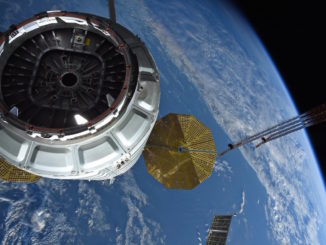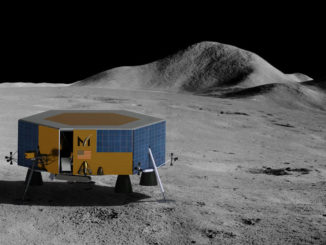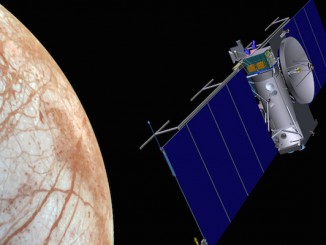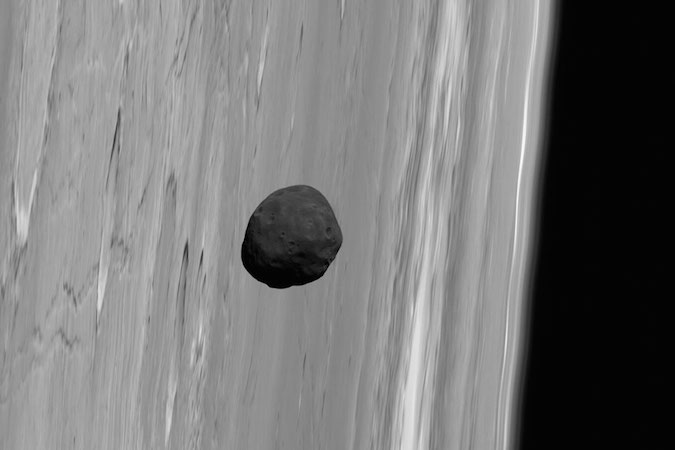
NASA’s MAVEN spacecraft in orbit around Mars maneuvered out of the path of Phobos earlier this week after navigators predicted the spacecraft could run into the Martian moon in the near future, highlighting the challenge of tracking an international fleet of Mars probes set to double in size by 2021.
The MAVEN orbiter, in its third year studying the Martian atmosphere, performed a minor rocket burn Feb. 28 to change its speed by less than 1 mph (0.4 meters per second), NASA said, tweaking its trajectory enough to dodge a projected collision with Phobos a week later.
On its new path, MAVEN will miss the irregularly-shaped moon by around two-and-a-half minutes. The rocket burn was MAVEN’s first collision avoidance maneuver to move out of the way of Phobos, NASA said.
Phobos is located around 3,700 miles (6,000 kilometers) above Mars, higher than the altitude of NASA’s other operational orbiters — Mars Odyssey and the Mars Reconnaissance Orbiter. But MAVEN is positioned in an elliptical orbit, carrying it as high as 3,800 miles (about 6,100 kilometers) on each lap around the planet before skimming the Martian atmosphere at the orbit’s lowest point.
The elliptical paths of MAVEN, India’s Mars Orbiter Mission and the European Space Agency’s Mars Express spacecraft make them often cross paths with Phobos and other probes. ESA’s ExoMars Trace Gas Orbiter is also flying in an oval-shaped perch, but ground controllers plan to begin maneuvering it into a lower circular orbit later this month.
Given Phobos’s size — the lumpy moon measures nearly 17 miles (27 kilometers) across on its longest axis — NASA said MAVEN had a “high probability” of colliding with Phobos on Monday, March 6, without the avoidance burn. The two were predicted to arrive at their orbit crossing point within seven seconds of each other.
Adding to the conservatism of NASA’s estimate, navigators at the Jet Propulsion Laboratory model Phobos’s size and shape as an 18-mile (30-kilometer) sphere when scanning for collision threats.
“Kudos to the JPL navigation and tracking teams for watching out for possible collisions every day of the year, and to the MAVEN spacecraft team for carrying out the maneuver flawlessly,” Bruce Jakosky, MAVEN’s principal investigator at the University of Colorado in Boulder, said in a statement.
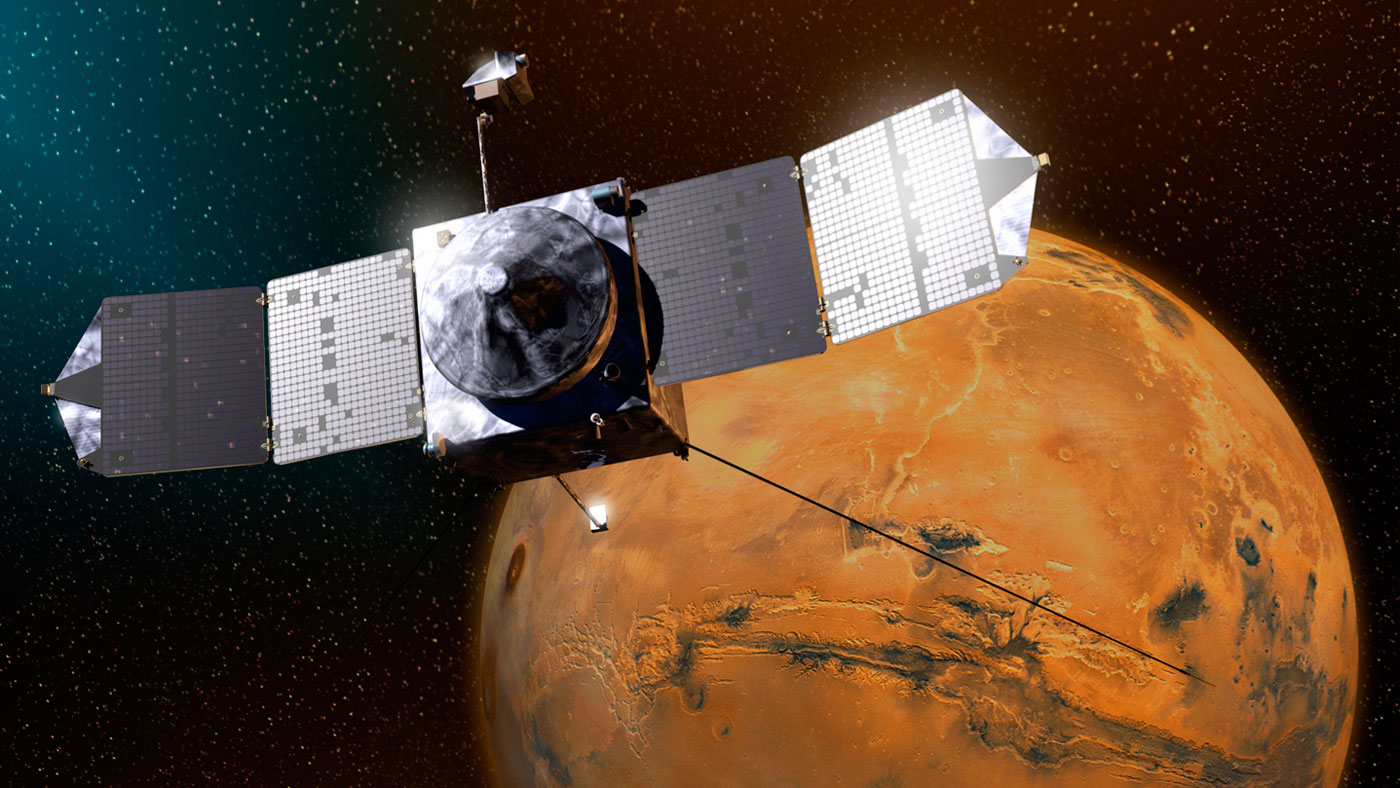
NASA announced in 2015 the creation of a formal collision avoidance framework called the Multi-Mission Automated Deep-Space Conjunction Assessment Process, in which experts at JPL will inform spacecraft operators around the world of possible close calls and impacts.
There are six operational orbiters currently around Mars from NASA, ESA and the Indian space agency. All of them rely, to some extent, on tracking and communications services from NASA’s Deep Space Network, a group of antennas located in Calif0rnia, Spain and Australia.
NASA tracks the orbits of each spacecraft, along with the approximate location of NASA’s defunct Mars Global Surveyor orbiter, to predict when they might get too close for comfort.
The Deep Space Network antennas also support NASA’s Opportunity and Curiosity rovers on the Martian surface, but links with the landers are usually relayed through one of the orbiters.
The international fleet of eight active spacecraft at Mars could double by 2021.
NASA is preparing to launch its InSight lander to the red planet in May 2018, with its arrival scheduled for November of that year.
There are up to six robotic missions set for departure to Mars in mid-2020.
NASA’s Mars 2020 rover, the joint European-Russian ExoMars rover, China’s first Mars mission, India’s second Mars orbiter, the United Arab Emirates Hope orbiter, and SpaceX’s commercial Red Dragon lander are all scheduled to launch in 2020 and arrive at the red planet around February 2021.
The Chinese mission includes two parts — an orbiter and a rover — making the total tally of spacecraft taking aim at Mars in 2021 at seven.
Fuk Li, director of JPL’s Mars exploration directorate, said Feb. 22 that NASA is already planning for the numerous arrivals, and evaluating what each mission will require from the Deep Space Network.
“Those missions are going in, and I believe all of them would like to have coverage as they go into the Martian system to allow them to see what’s going on,” Li said.
“That is a non-trivial request, given the types of missions and orbiters that we have, because they’re all coming in, time-wise, close to each other,” Li said in a meeting of the Mars Exploration Program Analysis Group.
The planning will likely include maneuvers to place existing orbiters on paths to fly over rover landing sites to relay signals between Earth and the Martian surface, while ensuring the spacecraft keep a safe distance from one another, according to Li.
“All these missions, potentially, will also require very detailed tracking in order to do the precision navigation to make sure they are entering orbit the right way,” Li said. “The month of February (2021), and a few weeks before that, will be extremely hectic, but we look forward to such things because of the science that will come after that.”
Each DSN antenna can track multiple spacecraft, Li said, and NASA is looking into activating all of the network’s antennas for the Mars arrivals.
ESA has its own global tracking network, but with smaller antennas than NASA. The first Chinese deep space tracking station outside of China is scheduled to open in Argentina this year, and India’s only interplanetary communications facility is on its own territory, meaning some of its deep space signals will have to be routed through NASA or ESA networks.
SpaceX and the UAE have agreements with NASA to use the agency’s Deep Space Network.
“It’s not really a data link issue,” Li said. “It’s a navigational tracking issue that comes up.”
NASA will also plan for emergencies and need to balance the extensive Mars mission requirements in early 2021 with the communications and tracking needs of probes transiting other parts of the solar system.
“If you have some some problem with some Mars spacecraft as it goes into orbit, with all of these other things coming into Mars,” Li said. “Let’s say MRO (Mars Reconnaissance Orbiter) has a problem — has a safe mode — what would we do? How would we react? And do we get priority over all the other missions?”
Email the author.
Follow Stephen Clark on Twitter: @StephenClark1.

